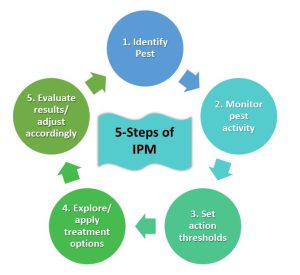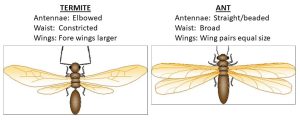You may have heard the term integrated pest management or the phrase ‘IPM’ tossed around in conversation by your pest control company, your landscape maintenance service, or even me – your local extension agent! So, you may be wondering what exactly is IPM? The simple answer is ‘IPM is a way to control pests without relying solely on pesticides”. But IPM is much more comprehensive than this simple response.
What IS IPM?
Integrated Pest Management, or IPM, is an environmentally sensitive and sound approach that focuses on long-term pest control. IPM is a combination of common-sense management practices which minimize negative impacts on human health, wildlife, and the environment. These practices incorporate techniques such as cultural and mechanical practices, habitat modification, and biological controls. IPM practices can be adjusted to any environment. When we think about using IPM at home, IPM methods can be adjusted to both landscape (exterior) pest management and urban (interior) pest management.
Prevention is the Key
Integrated pest management focuses on prevention since prevention is, by far, the most cost effective and least invasive approach to pest control. When thinking of IPM inside the home, focusing on prevention also supports a peace of mind knowing insects are NOT creeping around inside your home, but outside where they belong! Focusing on prevention also helps avoid more aggressive control measures, such as the use of chemicals, thereby eliminating possible negative impacts from their use.
IPM grew out of the concept of pest management in the agriculture sector. The concept, to apply pesticides only when the pest is present or when it is a pest that has the potential to grow to damaging numbers, has evolved into a comprehensive approach to pest management. The use of IPM does include the use of pesticides, but pesticide applications are no longer the first option or the ‘go-to’ for pest control.
Prevention is just that – taking steps that help minimize the chance of an insect infestation. Inside the home, a few examples are simple things such as replacing weatherstripping and caulking around entry points (doors and windows), fixing ripped or torn screens, or replacing the gasket in a leaky faucet. In the landscape, applying the proper amount of water and fertilizer will help eliminate pest problems typically associated with excessive water and nutrients.
Even with good prevention practices, pest problems sometime happen. In this case, there is a series of functional steps that can be followed to manage the pest problem and are applicable to any pest situation. These are known as the ‘5-steps of IPM’:
Step 1 – insect identification
The first step in IPM, proper insect identification, is worth mentioning in this blog since it is the key factor to a successful outcome. You need to know exactly what insect or ‘pest’ you are dealing with before you can formulate a plan to control it. A perfect example of this is finding a winged insect in your home and not knowing if it is a termite or an ant. Both termites and ants produce an ‘alate’ life stage during the year. ‘Alate’ is the winged, reproductive stages of the insect. Both look very similar, but control strategies for these insects (including insecticides) are very different! Also, the impact these insects can have on your home is also very different, so proper insect identification is key to creating a successful pest management plan.
You can try to identify the insect yourself using online resources or identification guides, but keep in mind ‘proper identification’ is vitally important. So, reach out to your local extension office. Extension is a great resource for helping with identification and it is very cost effective!
Also keep in mind that not all insects are pests. A cockroach inside the home is a pest, but outside they contribute to the broader ecosystem. Cockroaches are detritivores and help in the recycling of organic matter. They are also a primary source of food for many birds, reptiles, amphibians, and mammals. So, a cockroach on a landscape shrub is not a pest, but a cockroach under your sink most certainly is!
What IPM is NOT
Integrated pest management is not a spray-it-and-forget-it approach. Matter of fact, it’s not even close to a ‘spray it’ approach. Any pesticide application should be the very last step in an IPM plan and only after all other actions have been tried but unsuccessful. The old school of thought was to apply a broad-spectrum pesticide that had a long residual so it would continue to kill anything and everything that came in contact with it. This caused a buildup in pesticide resistance in some pest insects and negatively impacted beneficial insects and non-target organisms. As if that wasn’t bad enough, it also subjected people to toxic chemicals and produced unintentional consequences to environmental health. Thankfully we have evolved our thinking and have embraced a softer and more-environmentally friendly approach – and that is through using IPM to control pest problems.
Stay tuned for the next steps in IPM – monitoring and action thresholds
Further information: UF/IFAS Extension resource links on Integrated Pest Management:
EDIS Integrated Pest Management Subtopics
Source: UF/IFAS Pest Alert
Note: All images and contents are the property of UF/IFAS.





